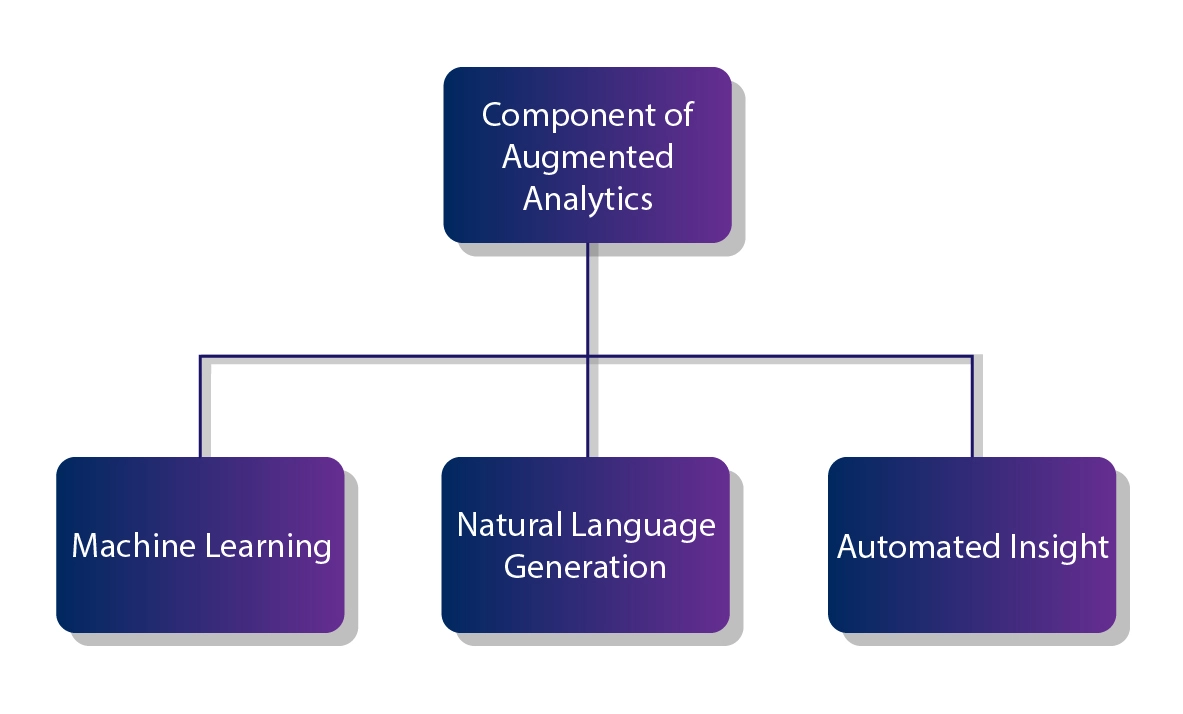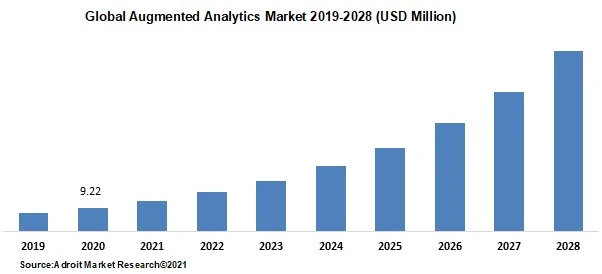- Blog
- April 4, 2022
Augmented analytics in the data economy

- Blog
- April 4, 2022
Augmented analytics in the data economy
In the age of volcanic information eruption, more and more data accumulate. In most cases, these tons and volumes of data produced are highly disorganized and difficult to interpret. Transforming the data to meaningful insights could be well-orchestrated through augmented analytics – the next-generation decision science tool for data scientists. Inc. says that up to 73% of a company’s data is not included in analytics.
Before we go further, let us start with
What is Augmented Analytics?
Automating the production of meaningful insights using the combination of machine learning (ML) algorithms and natural language generation refers to Augmented Analytics. It aims to significantly increase the usage of data and insights for precise decision-making. Augmented analytics does not require predefined data models, that is how it is different from traditional business intelligence (BI) and analytics tools.
A successful analytics method involves many steps. Instead of going through the steps and their various complexities, an organization can potentially go from data collection to actionable insights. It means that rather than simply discovering that customer demand in a specific region has decreased by x% in the last quarter, augmented analytics can tell you why and how to address the decline?
Key components of Augmented Analytics:
The augmented analytics strategy enables business users with no prior knowledge of data science to easily access and use analytics in a natural way. Machine learning (ML), natural language generation, and automated insights are some of the key components.

- Machine learning: Machine learning examines data by choosing and developing algorithms that process more data with greater precision than humans. It helps in providing findings based on reliable, contextual data, so you don’t have to rely on guesswork. The software assures that no data is lost by integrating and indexing large data collections.
- Natural language generation: Natural language generation is the use of artificial intelligence (AI) programming to generate written or spoken narratives from a data set (NLG). Most commonly used in automation scenarios for lead nurturing emails, SMS, and chat responses. To create endless value through data and analytics, global firms must embrace the digital disruptions introduced through AI wave with NLG.
- Automated insights: After machine learning and natural language generation, Automated insights are indeed the most significant component. ML-based algorithms are used to collect and process data. Automation powered by analytics improves the well-being of your teams. Traditionally, only a very few percentage of business analysts have used company data to create intelligence reports. New augmented analytics tools make it easier for everyone to access Augmented information.
Top 5 reasons why augmented analytics is popular in today’s data economy:
- Easy access: It can access the queries in plain English rather than having to write SQL queries. It eliminates the requirement for a technical expert and reduces the amount of time it takes to train employees.
- Cost reduction: Companies can use augmented analytics to quickly identify critical areas of their business that need to be optimized to boost their operating margins. They are moving much more rapidly and cost-effectively as a result of enhanced analytics.
- Data-driven decision:You can respond quickly to assure that everything is running smoothly for your customers, increasing their pleasure with your brand.
- Helps in decision-making: Employees are no longer required to undertake time-consuming tasks in order to create business outcomes as a result of the adoption of augmented analytics. You don’t need to prepare the data any longer; all you have to do now is look at it and make a business decision.
- Accelerate data transformation: In a click of a button, augmented analytics platforms can clean, integrate, and transform data from a variety of enterprise resource planning systems, providing data quality and profile reports.
Industries leveraging Augmented analytics:
- Healthcare: The healthcare industry has made a convincing case for incorporating augmented analytics into clinical decision-making to improve patient outcomes. Clinicians usually have ten years or more of specialized training and study under their belts. Healthcare executives rarely receive the same level of education and training to assist them in making key business decisions that have an impact on patient care. Companies with the right augmented analytics solutions are able to fill such gaps, allowing them to better focus on their attention and resources where they are needed.
- Manufacturing: Previously, budgeting and monitoring factory spending across geographically dispersed operations were stressful jobs that necessitated the use of spreadsheets, a thorough grasp of organizational silos, and a significant amount of time to collect and process all of the necessary data. Starting with a consolidated view of data across silos and timely information augmented by machine learning, IT creates the groundwork for greater planning and visibility with augmented analytics, so users and management can make more accurate, timely business planning projections.
- Supply chain: Traditional reporting software is incapable of keeping up with the demands of today’s fast-paced operations. Most reporting methods require the employment of a developer to configure reports, which results in increased costs and wasted time while waiting for clear and understandable results. By introducing augmentation into these processes, supply chains can automate to provide reports, real-time access, and eliminate repetitive procedures, saving countless hours and money.
- Government: Augmented Analytics. is adopted by Smart Cities across the world to process large amounts of data. Multi-level governance practices will fully enter the digital revolution as more smart cities adopt and use this transformational technology in their local administrations. Administrators will be able to simulate a “Smart City,” anticipate future environmental issues, and effectively manage their capital assets with this advanced technology in place.
“Augmented analytics is the future of data and analytics”, Gartner’s statement becoming true. As it does not only enable more businesses to operate successful analytic transactions but also save companies money, speed up decision-making, increase employee trust in data, and allow them to get a better return. In the projected period of 2022-2027, the Augmented analytics market is expected to develop at a healthy rate, reaching almost USD 25 billion by 2026.

Wrapping up:
Augmented Analytics is becoming a critical component for building your future intelligent enterprise. At MSRcosmos, we help customers in laying the foundation of augmented analytics using our unmatched data and ai capabilities. Customers rely on our contextual solutions for running their business in the most effective manner.




